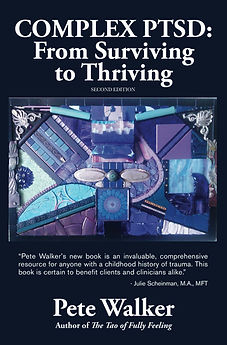Emotional Flashbacks
Emotional flashbacks are sudden, intense waves of fear, shame, grief, or helplessness often without any obvious trigger. These emotional states are not “overreactions”. They are relived emotional experiences from your past, especially from childhood.
Unlike traditional PTSD flashbacks, which may involve vivid imagery or sensory reliving of a traumatic event, emotional flashbacks are somatic and emotional. They can feel like:
-
A collapse into despair or panic
-
A drop into feeling “small,” “bad,” or “wrong”
-
A sense that you’re about to be punished, abandoned, or rejected
Important: These flashbacks are not about what’s happening now, but about what your nervous system remembers from the past.
Signs You’re in an Emotional Flashback
You may be experiencing an emotional flashback if you notice:
-
Sudden emotional overwhelm (shame, fear, sadness, or rage)
-
Feeling like a child again (powerless, dependent, invisible)
-
A strong urge to hide, run, please, or shut down
-
Thoughts like: “I’m a failure,” “No one loves me,” “I’m in danger”
-
Physical responses: nausea, heaviness, tension, racing heart
-
Forgetting your tools, your progress, or even who you are
Flashbacks often involve a temporary loss of your adult self, your grounded, resourced, rational perspective may seem far away.
Real-World Example: A Flashback in Action
Trigger: You send a message and don’t get a reply.
What happens: You feel instantly rejected. You spiral into shame. Thoughts like “I did something wrong” or “They hate me” flood your mind.
It’s not about the text. It’s about what it represents to you. It is an emotional flashback to childhood abandonment, rejection, or punishment.


Why Do Emotional Flashbacks Happen?
In childhood, when we experienced overwhelming feelings especially without support, safety, or attunement. Those feelings didn’t just disappear. They became trapped survival responses in the nervous system.
The emotional flashback is your body saying:
“Something here reminds me of danger. I’m protecting you.”
Triggers today can include:
-
Criticism, conflict, or perceived disapproval
-
Feeling ignored, dismissed, or left out
-
Making a mistake or “messing up”
-
Needing something from someone
-
Being too visible or not seen at all
Triggers often operate below our awareness, making them hard to spot. Triggers can be obvious like hearing a critical tone or seeing someone who resembles an abuser or subtle, such as feeling watched, making mistakes, or even feeling tired or hungry.
Authority figures and social situations often act as powerful triggers for survivors.
Managing Emotional Flashbacks: Pete Walker’s 13-Step Process
1. Notice What’s Happening
Say to yourself: “This feels like a flashback.” Flashbacks pull you into an old emotional state where everything feels unsafe. These are past feelings they can't harm you now.
2. Ground in the Present
“I feel scared, but I’m safe now.” Look around. You’re in the present not back in the past. This moment is different, and you're no longer trapped.
3. Claim Your Right to Safety
“I have the right to protect myself.” You don’t have to tolerate mistreatment. Boundaries are healthy, and you can walk away if something feels wrong.
4. Soothe Your Inner Child
“I’m here with you. You’re not alone.” Offer comfort to the part of you that feels small. Be the safe support you once needed.
5. Remember: This Will Pass
Flashbacks feel endless but they’re not. “This is temporary. I’ve felt this before, and I got through it.” You’re not stuck, even if it feels that way.
6. Reconnect with Your Strength
Feel your feet on the ground. “I’m an adult now, with choices and support.” You’re not powerless anymore you have tools and people who care.
7. Return to Your Body
Flashbacks can pull you out of your body. Soften tense muscles, slow your breath, and find a calm space wrap in a blanket, hold a pillow, lie down. Let your body know it’s safe. Fear is just a state it will pass.


8. Quiet the Inner Critic
When your inner critic shows up with fear or shame, say “No” with kindness. Stop the spiral and gently remind yourself of your strengths and worth. Replace harsh thoughts with truth and self-compassion.
9. Allow Space to Grieve
Flashbacks often bring old pain to the surface. Let the tears or anger come it’s part of healing. Grief allows you to release the past and reconnect with your strength.
10. Reach Out for Support
You’re not alone. Let trusted people know what you’re going through. Connection helps counter shame. Being seen and supported makes a difference.
11. Notice Your Triggers
Start to observe what tends to set off flashbacks people, situations, or even thoughts. Awareness helps you set boundaries, prepare, and take care of yourself.
12. Understand the Roots
Ask gently: What does this remind me of? Flashbacks often reflect past pain or unmet needs. Recognizing them is a step toward healing.
13. Be Patient with the Process
Recovery takes time. Progress can be slow and uneven, and that’s normal. Each flashback is an opportunity to grow stronger and more self-aware. Be gentle with yourself healing is unfolding.
If you find yourself struggling with emotional flashbacks or childhood trauma, I offer personalized therapy sessions online and in person in Eindhoven and Veldhoven. Find out more about me here.
Reference
Insight and language in this post is adapted with gratitude from Pete Walker’s book "Complex PTSD: From Surviving to Thriving", which offers compassionate guidance for navigating emotional flashbacks and recovering from childhood trauma.


